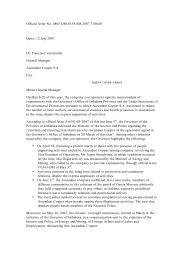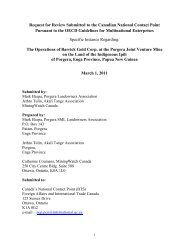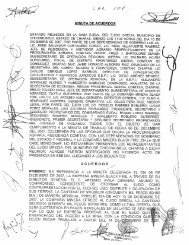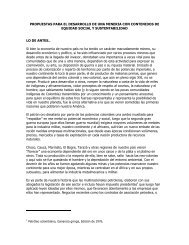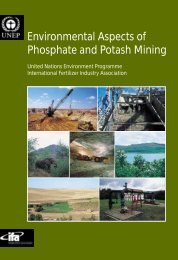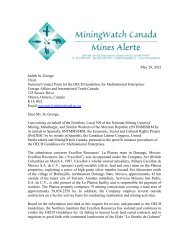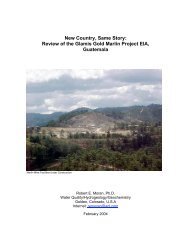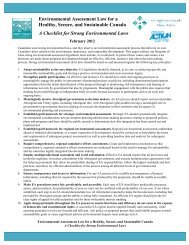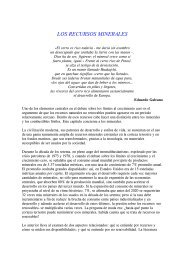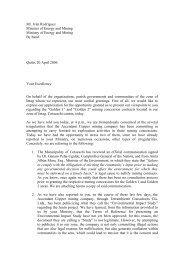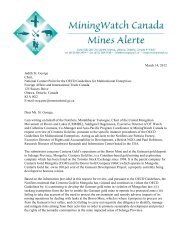Mining in Remote Areas Issues and Impacts - MiningWatch Canada
Mining in Remote Areas Issues and Impacts - MiningWatch Canada
Mining in Remote Areas Issues and Impacts - MiningWatch Canada
You also want an ePaper? Increase the reach of your titles
YUMPU automatically turns print PDFs into web optimized ePapers that Google loves.
Labrador who feel the m<strong>in</strong><strong>in</strong>g activity<strong>in</strong> the area has costs for theirfamilies <strong>and</strong> the environment. (47)A professor at Memorial University<strong>in</strong> Newfoundl<strong>and</strong> has found thatfor married workers, long absencesfrom home can contribute to marriagebreakdowns <strong>and</strong> disrupt familylife.(49)If male partners are employed atm<strong>in</strong>es that require them to be awayfrom home for weeks or months at atime, the primary responsibility formanag<strong>in</strong>g the household (provision<strong>and</strong> preparation of food, subsistenceharvest<strong>in</strong>g, care of cloth<strong>in</strong>g, housework,ma<strong>in</strong>tenance of household accounts,childcare) will fall to women.This can potentially affect women’sparticipation <strong>in</strong> community life.Miriam Wall, writ<strong>in</strong>g on the impactof resource developments onwomen <strong>in</strong> northern Ontario states,“Time is a premium for manywomen. As mothers they often cannotafford to be away over night orfor long periods of time… work<strong>in</strong>gwomen, who f<strong>in</strong>d themselves overburdenedwith both their paid employment<strong>and</strong> traditional family role[can be] effectively excluded fromfurther <strong>in</strong>volvement <strong>in</strong> community.”(48)Wall also writes that job opportunitiesmay be limited for women <strong>in</strong>s<strong>in</strong>gle-<strong>in</strong>dustry towns. The traditionalemployment options availableto women tend to be <strong>in</strong> the lowpay<strong>in</strong>g,service sector. Moreover,there is a certa<strong>in</strong> “mill mentality”that exists <strong>in</strong> s<strong>in</strong>gle-<strong>in</strong>dustry towns,Community<strong>Impacts</strong><strong>M<strong>in</strong><strong>in</strong>g</strong> extracts toll on47 Innu women of Labrador(Herizons W<strong>in</strong>ter 1997; v.11(1); pg 6-7.)Innu women leaders fear history isrepeat<strong>in</strong>g itself with the frenzy of m<strong>in</strong><strong>in</strong>gactivity <strong>in</strong> Northern Labrador. In 1993,what is believed to be the world’s largestnickel reserve was found <strong>in</strong> Voisey’sBay, located on Labrador’s north coast.The m<strong>in</strong><strong>in</strong>g boom was cheered on BayStreet, but women <strong>in</strong> the region areconcerned about how this newest <strong>in</strong>vasionof their homel<strong>and</strong> will affect theirfamilies, their environment, the heal<strong>in</strong>gprocess <strong>and</strong> l<strong>and</strong> claims negotiations.Case Study: Ross River, Yukon TerritoryThe follow<strong>in</strong>g case study is composed of <strong>in</strong>formation fromthe report “Just Like People Get Lost: A retrospective assessmentof the impacts of the Faro <strong>M<strong>in</strong><strong>in</strong>g</strong> Development on thel<strong>and</strong> use of the Ross River Indian People.”(31) In the report,the author makes it clear that while there were impacts directlyattributable to the m<strong>in</strong><strong>in</strong>g development, there wereconcurrent factors, such as changes <strong>in</strong> education, transportation,employment, <strong>and</strong> social welfare programs, that contributedto the severe social problems experienced by the aborig<strong>in</strong>alcommunity of Ross River.Beg<strong>in</strong>n<strong>in</strong>g <strong>in</strong> 1966, there was an <strong>in</strong>flux of outsiders <strong>and</strong>bus<strong>in</strong>esses to Ross River to service the construction <strong>and</strong> operationof the Faro m<strong>in</strong>e. In the ensu<strong>in</strong>g years the Ross Riverb<strong>and</strong> experienced <strong>in</strong>creased “dr<strong>in</strong>k<strong>in</strong>g, open conflicts, violence,sexual exploitation . . . the dis<strong>in</strong>tegration of somemarriages.”The <strong>in</strong>ternal problems among the aborig<strong>in</strong>al people wereexacerbated by the arrival of large numbers of transientwhite male labourers dur<strong>in</strong>g the construction period. Many ofthe m<strong>in</strong>e construction workers carried the stereotypic imagesof “Indians as victims <strong>and</strong> powerless,” that were prevalent <strong>in</strong>Yukon <strong>and</strong> many other areas of <strong>Canada</strong> at that time. Womenwere seen as sexual objects <strong>and</strong> the men, when drunk, wereseen as objects for abuse <strong>and</strong> violence. Raids by constructionworkers to abduct women from the village were not uncommon.There have been vivid descriptions of sexual exploit a-tion <strong>and</strong> beat<strong>in</strong>gs of Natives by whites at the local bar.Many of the southerners who settled <strong>in</strong> the village broughturban ideas, values <strong>and</strong> behaviour.The parents of non-Native childrendem<strong>and</strong>ed a southern school curriculum<strong>and</strong> were <strong>in</strong>strumental <strong>in</strong> gett<strong>in</strong>g the school pr<strong>in</strong>cipal,who was sympathetic to the differ<strong>in</strong>g needs of the Indianchildren, dismissed. Thus, even aborig<strong>in</strong>al children were <strong>in</strong>volved<strong>in</strong> the disempowerment.The impact of roads, the stresses of village life, the dislocationof some family groups from their traditional l<strong>and</strong>s, <strong>and</strong>the rapid transformation <strong>in</strong>to a marg<strong>in</strong>al m<strong>in</strong>ority changedthe lives of the Ross River people forever. When thesechanges comb<strong>in</strong>ed with the ready availability of alcohol,however, they produced a deadly comb<strong>in</strong>ation. Public facilitiesfor the purchase of alcohol became available <strong>in</strong> the regionwith the <strong>in</strong>flux of m<strong>in</strong>e construction workers. As all ofthe stresses to life <strong>in</strong> Ross River developed, extended periodsof b<strong>in</strong>ge dr<strong>in</strong>k<strong>in</strong>g became the rule. When people returnedfrom a job with cash, alcohol would be bought <strong>and</strong> sharedwith friends <strong>and</strong> relatives until the money was spent.Deaths from a variety of alcohol related causes, mostly accidents,began to occur <strong>in</strong> 1966. From that time to the present,death from alcohol-related causes has been a regularevent for the Indian population, with one or more deathsfrom dr<strong>in</strong>k<strong>in</strong>g almost every year between 1970 <strong>and</strong> 1989.The community of Ross River is <strong>in</strong> the process of heal<strong>in</strong>gfrom the negative social effects that have so drasticallychanged their way of life <strong>in</strong> the past 30 years. In light of the<strong>in</strong>def<strong>in</strong>ite closure of the Faro m<strong>in</strong>e <strong>in</strong> 1998, the people ofRoss River must now try to develop strategies for build<strong>in</strong>g amore healthy, susta<strong>in</strong>able community.<strong>M<strong>in</strong><strong>in</strong>g</strong> In <strong>Remote</strong> <strong>Areas</strong>: <strong>Issues</strong> <strong>and</strong> <strong>Impacts</strong> 15



